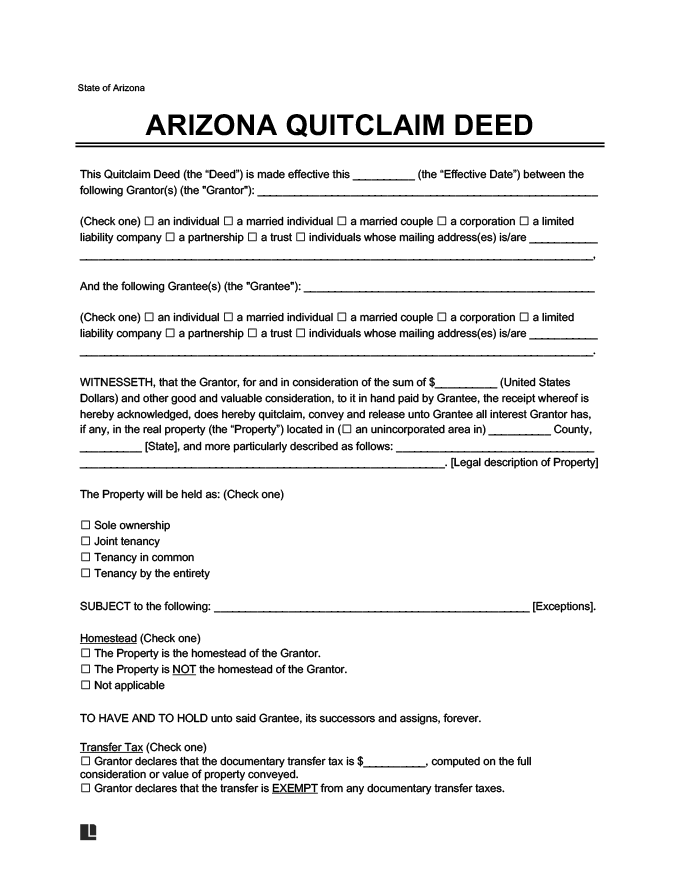An Arizona quitclaim deed transfers real estate without a guarantee of title. Unlike in a grant deed or warranty deed, the person transferring the property (the grantor) is not making any promise to the new owner (the grantee) that they have any right to transfer it.
Quitclaim deeds are frequently used for situations like divorce or testamentary transfers when both parties are familiar with each other and know the property can be transferred without title issues.
Legal Framework
Ariz. Rev. Stat. § 33-401 outlines the legal right for individuals to transfer real property ownership through a quitclaim deed. Here are some key requirements for a valid quitclaim deed in Arizona:
Legal Description
The legal description must be the exact one that appears on the previous deed to the property. Any mistakes or errors may invalidate the deed.
Note that the legal description may appear on the back or on a second page. If the current deed says “See Exhibit ‘A'” and you do not have Exhibit A, there may be a page missing from your deed.
Signing
- Per Ariz. Rev. Stat. § 33-401, the grantor must sign in the presence of the notary. Deeds do not need witnesses.
- After signing the deed, it needs to be recorded with the County Recorder’s Office for the transfer to become publicly known and official.
Terminology
The deed must contain language indicating vesting of title in the grantee or grantees. According to Ariz. Rev. Stat. § 33-402, the language should be similar to: “I [grantor] hereby quit claim to [grantee] all my interest in [property] .” The language should be similar to: “I [grantor] hereby quit claim all my interest in [property] to [grantee].”
Additional Documents
If the property is being sold for value, an Affidavit of Property Value (Form 82162) may need to be attached to the quitclaim deed. The sale price will be included on the deed, but the sale may need the valuation.
Quitclaim deeds for gifts (no monetary value) or nominal amounts skip the Affidavit of Property Value, but the deed itself must clearly state the exemption (Ariz. Rev. Stat. § 11-1134).
Filing
- Once the document is complete and signed, it should be taken or mailed to the Recorder’s Office in the county where the property is located (Ariz. Rev. Stat. § 11-468).
- If it is mailed, include a self-addressed, stamped envelope for all deeds and copies to be returned.
Validity Requirements
A valid deed must contain all of the correct signatures and language, and in addition, it must meet the formatting requirements according to Ariz. Rev. Stat. § 11-480:
- Caption: The nature of the instrument (e.g., warranty deed, quitclaim deed).
- Legibility: It needs to be an original document clear enough for making certified copies.
- Signatures: The deed must have original signatures (unless otherwise allowed by law).
- Size and font: Be no larger than 8.5″ wide and 14″ long, with a minimum font size of 10 points (for instruments dated after January 1, 1991).
All sides need a half-inch margin, and anything written within that area might not be included in the official record. The first page needs a two-inch top margin for recording information. There’s also a designated space on the first page for the person requesting the recording to include their name and return address.
A separate sheet with the correct margins and document title can be attached if the margins aren’t met. Lastly, documents modifying previously recorded ones must mention the recording details of the original document.
Content Requirements
A valid quitclaim deed must include the following:
- Vesting language that properly transfers ownership of the property from the grantor to the grantee.
- Language describing how multiple owners will hold title to the property — for instance, “as tenants in common” or “as joint tenants with right of survivorship.”
- A valid legal description matching the legal description of the previous deed.
- Signatures of both parties, notary signature, and stamp.
- If property is being quitclaimed to or from a trust, the deed must include the name of the trust, the trust beneficiaries, and the recording information of the Certificate of Trust.
Quitclaim Deeds vs. Other Property Transfer Methods
| Quitclaim Deed | Only gives the grantee what interest the grantor presently has. This does not guarantee that the title is clear or even that the grantor has the right to convey. |
| General Warranty Deed | Guarantees the title is free of liens and encumbrances. Grantor has the right to convey the title. |
| Special Warranty Deed | Grantor will defend the grantee’s title only against claims during the period of the grantor’s ownership. |
| Life Estate Deed | Grants the new owner the right to take possession of the property immediately upon the death of the life tenant. |
| Beneficiary Deed | Gives beneficiary ownership through a transfer-on-death (TOD) deed. Life tenant can revoke TOD designation at any time during their life, but this avoids probate upon death. |
